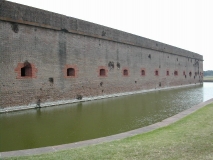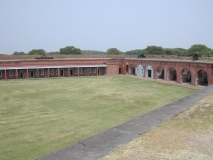The weather was expected to be hot, so we got up very early in the morning to do our workout. While running, I often wonder what it was like for the Civil War soldiers to march and fight in the summer heat. Working out in light clothes designed for activity is hard enough; I can’t imagine what it would be like to wear wool clothes and carry a heavy pack in this climate — especially when people are shooting at you.
About mid-morning we headed to Fort Pulaski, which was one of a series of forts built along the Atlantic and Gulf coasts during the early 1800s. This particular fort was named after a Polish general, Casimir Pulaski, who died fighting against the British during the American Revolutionary War. The fort was completed before the Civil War and was briefly occupied by Confederate troops before it was re-taken by Federals early in the war. Its strategic location at the mouth of the Savannah River allowed the Federals to blockade the port of Savannah.
The story of the battle is interesting since the Confederates were surprised when the Federals used rifled cannons — one of the first times the new weapon had been used during the war. Of course, the Federals knew the layout of the fort and pounded the area of the powder magazine. After only 30 hours of bombardment, the Confederate commander realized his situation was hopeless and surrendered. You can still see where the Federal shots hit the walls of the fort. The lesson of the battle was that new technology ended the era of fixed fortifications.
After visiting the fort we stopped for lunch on nearby Tybee island before the heat and humidity drove us back to the air conditioned comfort of the coach.
That evening after an underwhelming meal at a local steakhouse, we stopped at a Bank of America ATM to get some cash. Without explanation or cash, the machine kept our card. The helpful folks at the Bank of America ATM call center advised us to call the issuing financial institution to cancel the card and close our account. Furthermore, they said the bank policy was to destroy the card for my “protection”. Say What!? After 45 minutes of conversation conducted in a controlled and professional manner, I left no doubt what MY policies and expectations were. Plan B is to visit the branch Monday morning at opening to discuss the issue with the Branch Manager.
The reader should note that Bank of America is the same company that charged $20 for a date-of-death valuation report (required for a federal tax filing) for my mother’s account after she had banked there for 49 years.
Contemporary note: Having the bank charge for a report that all other financial institutions provided for free was the last straw. I sent a letter to the Senior VP for Consumer Banking a letter thanking her for supporting the rate of return to shareholders on the backs of dead depositors. At the time we were shareholders of Bank of America stock. We sold the stock and to this day we refuse to do business with Bank of America.







